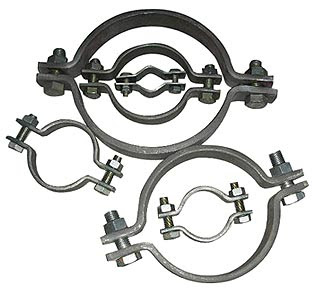Clamps
Pipe Clamps
by Hi-Tech on Jun.10, 2010, under Clamps, Pipe Fasteners
The pipe clamps are special type of fasteners suitable for clamping pipes, hoses and electric cables. Pipe clamps are a sensible and easy way of securing piping, tubes and hoses in all types of terrestrial or naval installation. They are designed for use in water/plumbing purposes. They are also used for mounting of pipes to the walls. Some pipe clamps can also be mounted on piping components other than straight pipe. There are also heavy-duty structural pipe clamps designed for use with standard size water/plumbing pipe that is not threaded. Many pipe clamps have solid cores for added strength. The pipe clamps are sometimes controlled by pressure activated cylinders to regulate the clamping pressure in relationship to the thickness and strength of the pipe wall.

Buying Tips
Pipe clamps can be ordered as complete arrangements or separate components. Certain factors to consider to buy pipe clamps are as follows:
- Type of clamp
- Size
- Material
- Finish
- Durability
- Mechanical Properties
- Tensile Strength
- Flexural Yield Strength
- Impact Strength
- Tensile Test
- Thickness
- Modules of Elasticity
- Thermal Properties
- Continuous Service
- Temperature Range
- Electrical Properties
- Volume Resistivity
- Chemical Properties
Pipe clamps usually have one fixed pad, and one adjustable pad. Pipe clamps are constructed using various materials and are available in several configurations with a variety of finishes. Metallic pipe clamps have high impact resistance and various finishes like a brilliant, glossy finish, heat-resistant coatings and epoxy coatings or plain look or hot-dip galvanized or painted.
Various materials used are as follows:
- Carbon steel
- Mild steel
- Stainless steel
- Alloy steel
- Titanium
- Aluminum
- Thermoplastic elastomer
- Polypropylene
- Polyamide
- PVC etc.
Various types of pipe clamps are as follows:
- Rigid Clamps
- U-Bolt Clamps
- Flat Cushion Clamps
- Oval Clamps
- U-Bolt with Cushion Clamps
- P Style Clamps
- Swivel Bolt Clamps
How to measure pipe clamps?
Take the measurements of the following:
- Diameter
- Outside diameter of pipe
- Cap nut diameter
- Load ability
Common features of pipe clamps are as follows:
- Simple to operate
- Easy to install
- Adjustable in small range
- Good appearance
- Temperature range is dependent on the clamp lining being used.
- All pipe clamps are designed to have a very high impact resistance.
- Make for quick, easy pipe installation and layout.
- Shock-absorption
- Vibration dampening
- Noise reducing property
- Heavy torque
- Usually used for large diameter pipes etc.
Mounting Guidelines of pipe clamps:
- The clamp should be mounted directly after the threaded connection or coupling of the piping which in turn protects the connection from vibrations.
- Bends in the line should be clamped on both sides of the pipe bend.
- The pipe line should be clamped directly before and after any in-line valves.
- Proper Torquing of the clamp bolts is very essential.
Some uses of pipe clamps are as follows:
- Used for fastening and fixing various pipelines whether in construction or industries or buildings etc.
- Provide fast, safe, economic service and installation in piping system.
- Pipe clamps are designed for a wide range of fastening applications.
- These clamps are ideal for suspension of cold or hot pipe lines with heavy load having little or no insulation.
- They are also used for high and even tightening force around the pipe, minimizes leakage.
- The pipe clamps absorb shock, dampen vibration, and reduce noise in plumbing systems.
- They can be used in high temperature applications.
Applications of pipe clamps:
Pipe clamps are used in general industrial pipe construction, in all areas of residential, industrial, mobile and marine hydraulics, the field of press technology, instrumentation and control technology, and many other application fields.

